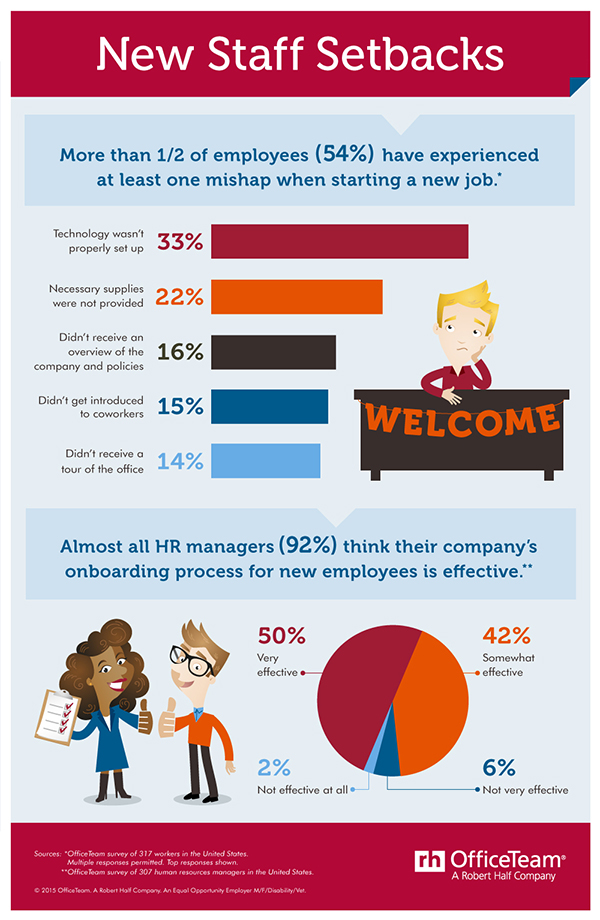It’s important for new employees to make a good first impression, but many companies don’t realize they also need to put their best foot forward. A new study suggests that a great many new hires are experiencing hiccups during their onboarding processes—and HR pros don’t seem to see the problem.
Recent research from staffing firm OfficeTeam—a Robert Half company—found that more than half (54%) of workers interviewed said they’ve experienced at least one mishap when starting a new job. For one-third (33%) of those surveyed, their computer, phone, or security access wasn’t properly set up when they arrived. Another 22% said necessary supplies were not provided at the outset.
Despite these first-day troubles, however, most human resources (HR) managers give their companies high marks when it comes to bringing new employees into the fold: Half (50%) of those polled felt their organization’s onboarding process is very effective and 42% stated it’s somewhat effective.
Have you noticed that some of your employees have the potential to be effective leaders? Get them the training they need with BLR’s TrainingToday Leadership for Employees Library. Get the details here.
“Many companies focus so much on information-sharing during an onboarding process that they may overlook basic practical needs, such as making sure that a workstation is up and running for the employee,” said Robert Hosking, executive director of OfficeTeam. “Every touchpoint during those first days adds to the new staff member’s perception of the organization, so the more you can do to ensure everything runs smoothly, the more positive that impression will be.”
OfficeTeam offers five tips for getting employees up to speed when starting a new job:
1. Set up shop. Stock the desk with essential supplies and equipment, such as pens, notebooks, a computer, and a phone. Confirm network, voice mail, and e-mail functionality. Coordinate building security access, if necessary.
2. Get acquainted. Send a welcome e-mail to team members and alert the receptionist so everyone’s aware. On the first day, introduce the employee to coworkers around the office. Consider scheduling a lunch for the new hire to get to know colleagues. Assigning the worker a buddy or mentor can help ease his or her transition.
3. Review the essentials. Provide a tour of the building. Schedule an orientation to review the employee handbook, company history, and policies. Allow time to complete any required HR paperwork.
4. Focus on the job at hand. Set expectations early on by discussing the position’s goals and responsibilities. Organize training sessions on office equipment, software, and procedures necessary for the role.
5. Keep it going. It can take a few months to fully onboard a worker. During that time, regularly check in with the employee and encourage him or her to ask questions.
Trying to get your employees trained to show leadership? It isn’t easy to fit it in—schedulewise or budgetwise—but now there’s BLR’s Leadership for Employees Library. Train all your people, at their convenience, 24/7, for one standard fee. Get More Information.
The infographic below highlights some of the key findings from the survey.

Ineffective onboarding can damage engagement right off the bat. In tomorrow’s Advisor, we share a guest author’s take on one strategy to drive engagement throughout the company—gamification.
